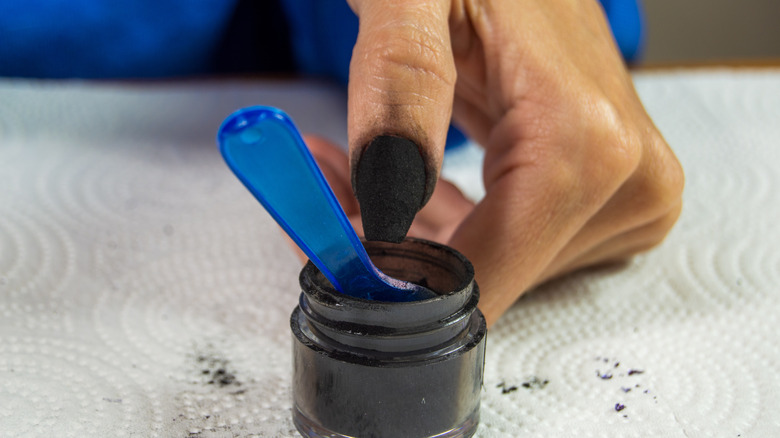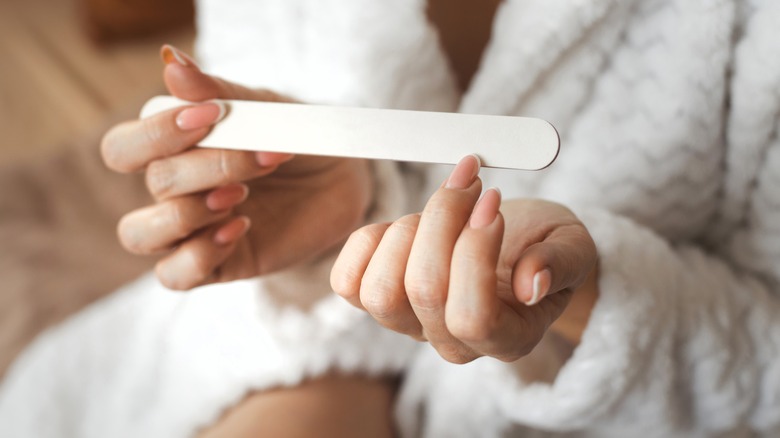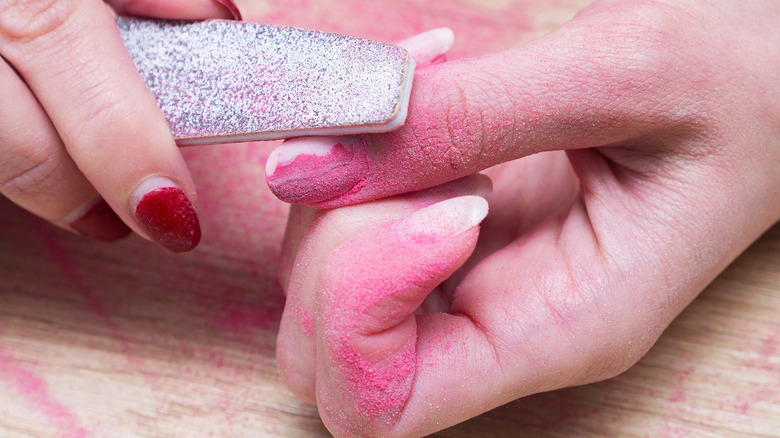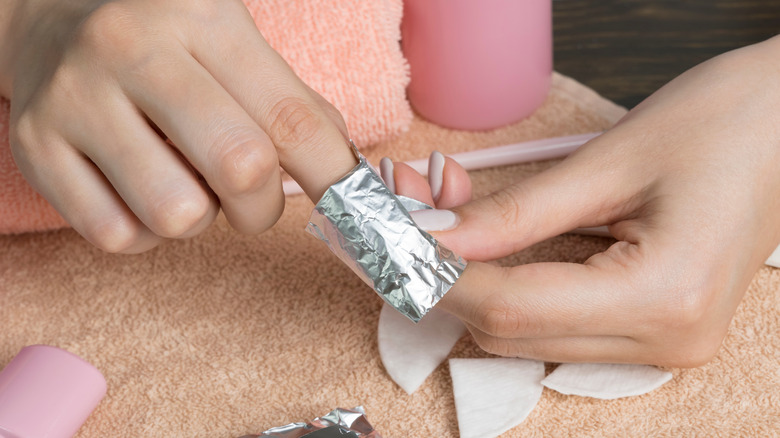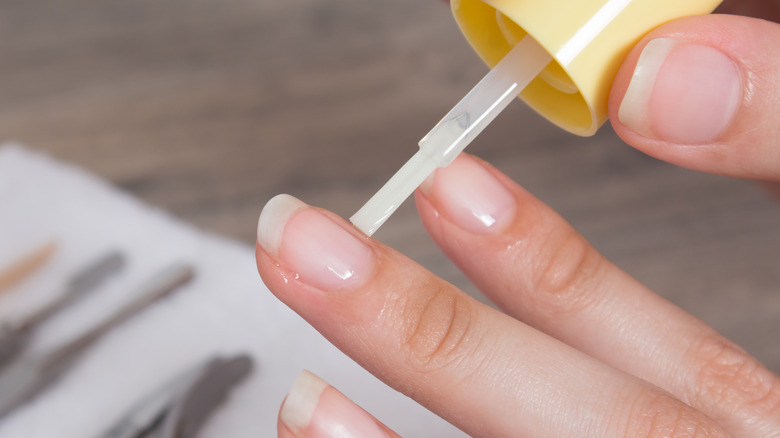The Easiest Tips For Removing Dip Powder Nails At Home
Dip powder is one way to stretch out the life of your mani, and who doesn't love a look that lasts? If you're new to a dip powder manicure, it involves dipping your nails into a colored acrylic powder that adheres to the nail with a bonder or primer polish. After applying the powder, it's finished with a clear sealant. The typical lifespan of a dip powder manicure depends on how well it's applied, but many claim that it lasts two to four weeks without the need for touch-ups. It's easy to do at home, and you don't need to cure with a UV light as you would with gel nails. Plus, there are endless color options to choose from.
However, while dip powder is easy to apply, it can sometimes create a thick, tricky manicure to remove. Regular nail polish remover, which contain acetone solvent diluted in a material are not strong enough to remove the multiple layers of product, like the sealant. But with the right tools and tips, you can easily remove them at home and avoid damaging your nails. You'll need a few things: a coarse nail file, acetone, cotton pads, foil, and a cuticle pusher.
Use the correct products
It's tempting to try and opt for alternative solutions like vinegar and lemon, but according to Allure, many nail experts stress that this isn't a good idea. For one, it may be just as drying as nail polish remover, but for two, it may not actually be strong enough to remove the layers of product. In fact, Lab Muffin tested out natural nail remover remedies on gel polish and found it not effective, so it's safe to assume that it likely wouldn't work for even sturdier dip polish.
Instead, nail artists stress that the most effective way to remove dip product is with pure acetone. As explained by Sinclair Dermatology, acetone is a solvent works by breaking down the ingredients like resin in polish. This makes it more effective at removing nail polish than regular removers that are 'acetone-free' or made with ethyl acetate. You'll want to make sure you use 100% pure acetone when removing your dip powder for best results.
When it comes to removing stubborn dip powder nails, some nail techs recommend actually warming the acetone, as it may work quicker than acetone at room temperature. However, it's extremely important to note the acetone is highly flammable and should not be heated on the stove or in your microwave. Healthline recommends manually warming an empty bowl in a basin or larger bowl of hot water. You can then add the acetone to that warmed bowl to warm it up. It does not need to be boiling for it to work.
Remove the top layer before you begin
Since dip powder is stronger than regular polish, removing it can be time consuming. You can speed up the removal process by buffing off the top layer of polish first.When you're ready to remove your dip powder manicure, take out a nail file and file away the top layer of the manicure. Nail technician and nail health expert Evelyn Lim suggests using a file with 180/100 grit, as explained in an interview with Byrdie. You don't have to use a lot of pressure or file harshly; it's best to be gentle so you don't end up accidentally damaging your nail plate. You'll know you've done enough when the top layer is dull and white dust appears.
This tip will help get the hard sealant layer off make it easier for the acetone to dissolve the color. The more you can file away, the less you'll have to soak. If you have any added extension for nail length, it may also help to trim the nails back to their original length. Nail artist Ashlie Johnson told Allure that this also speeds up the removal process.
Wrap nails in foil or use a bowl
Once you've filed away the top layer of polish, you'll need acetone, foil, and some cotton pads. The foil wrap is meant to hold the acetone-soaked cotton on top of the nail so it can dissolve the powder. It also helps to keep your carpet or countertop cleans, as acetone can damage surfaces.
You can purchase specially made foil nail wraps with cotton on the inside, or you can simply use small pieces of aluminum foil from your kitchen and pack them with cotton pads soaked in acetone. This saves you the effort of vigorously rubbing a cotton pad soaked with acetone on every single nail. Leave the wraps on for 10-15 minutes. If the powder isn't fully coming off the nail yet, nail artist Evelyn Lim tells Byrdie it's fine to give them as second soak for an additional 10 minutes until the product starts to crumble. From there, you can gently rub off the product.
Alternatively, you can soak your nails in a bowl of acetone is another way of removing the dip powder. Nail artist Amy Le advises that if you do go for the acetone bath, rub petroleum jelly on your fingertips and cuticles (not the nails). "This will help prevent the skin around your nails from drying out," Le told Allure.
Don't get another dip powder manicure right away
Although the acetone generally does a decent job removing all the dip powder, you'll likely have some residue left over when you remove the foils from your fingers. As nail artist Evelyn Lim tells Byrdie, this remaining product be scraped away with a cuticle stick, nail buffer, or wooden nail stick.
After finally removing the product, you may feel ready to add new polish. However, along with the dip powder itself, acetone is a strong chemical that can over time, weaken the natural nail or dry them out.
Each time you remove a dip manicure, you're exposing your nails to this product. For this reason, many experts say it's best to not rush to getting another dip powder manicure immediately after removing your last one. Manicurist and salon founder Joy Terrell tells Byrdie at the minimum, you should wait a week before hitting the salon again. However, the American Academy of Dermatology recommends waiting as long as a month between applications to be on the safe side so you don't constantly put acetone on your nails to remove them.
In the meantime, be sure to use a nail strengthener and cuticle oil on the nails when you're finished removing your dip polish. This will restore moisture to your nails so they can stay healthy and strong.
If you notice your nails feel brittle and worn out after your manicures, take longer breaks between them.
